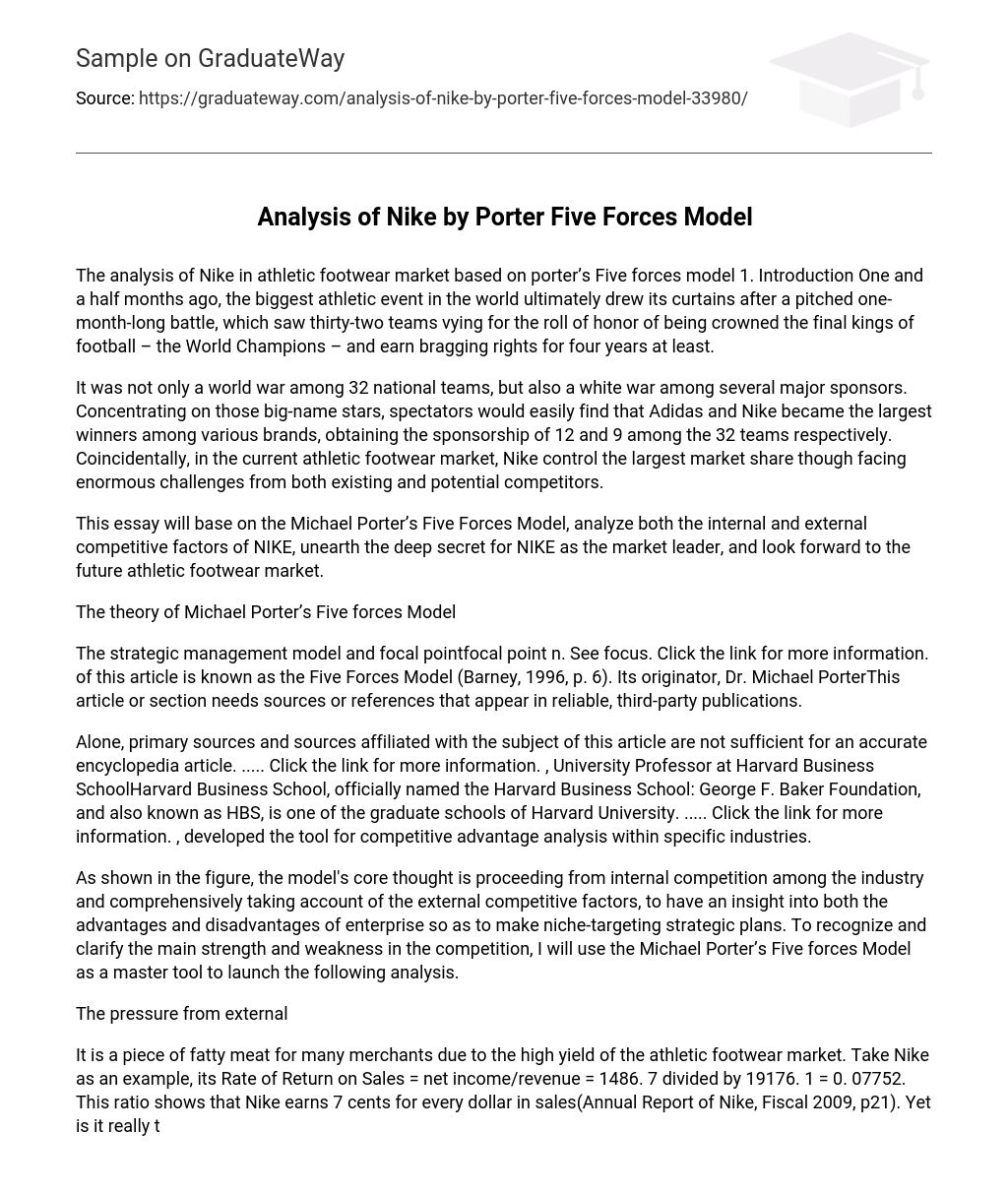The analysis of Nike in the athletic footwear market is based on Porter’s Five Forces model.
1. Introduction: One and a half months ago, the biggest athletic event in the world ultimately drew its curtains after a pitched one-month-long battle, which saw thirty-two teams vying for the roll of honor of being crowned the final kings of football – the World Champions – and earn bragging rights for four years at least.
Not only was it a worldwide battle among 32 national teams, but it was also a fierce competition among major sponsors. The focus on famous players made it clear that Adidas and Nike emerged as the most successful brands, securing sponsorship deals with 12 and 9 teams respectively out of the 32. Interestingly, in the present athletic footwear market, Nike continues to dominate with the largest market share, despite facing significant challenges from both current and prospective rivals.
In this essay, the analysis of NIKE’s internal and external competitive factors using Michael Porter’s Five Forces Model is conducted. The main aim is to identify the key elements that have contributed to NIKE’s current position as a market leader in addition to evaluating the future prospects of the athletic footwear industry.
The concept of Michael Porter’s Five Forces Model
The primary idea of the model is to assess both internal industry competition and external competitive factors. This analysis aids in comprehending a company’s strengths and weaknesses, which can support the creation of strategic plans. To identify and clarify these strengths and weaknesses within the competitive landscape, I will utilize Michael Porter’s Five Forces Model as a vital analytical tool.
The pressure from external
The high yield of the athletic footwear market makes it a lucrative business for many merchants. Using Nike as an example, its Rate of Return on Sales is calculated by dividing net income by revenue, resulting in a ratio of 0.07752 (Annual Report of Nike, Fiscal 2009, p21). This means that Nike earns 7 cents for every dollar in sales. However, is it equally easy for other investors to make profits? To evaluate the potential of the athletic footwear market, four main factors need to be considered. First, the threat of substitute products or services is minimal and unlikely to impact the existing footwear market. Footwear is a daily necessity, and athletic shoes are essential for sports.
Diverse sports have different requirements for sneakers, leading to a high demand for athletic footwear. It is important to consider the bargaining power of both suppliers and customers. Nike’s suppliers have limited bargaining power due to the company’s extensive raw material sources worldwide. In fiscal 2009, China, Vietnam, Indonesia, and Thailand produced 36%, 36%, 22%, and 6% of Nike brand footwear respectively (Source – Annual Report of Nike, Fiscal 2009, p4).
The limited bargaining power of suppliers and customers is apparent in Nike’s manufacturing processes. Each supplier and customer only contributes a small portion, therefore their influence on the price and market position is minimal. While competition prevents Nike from freely increasing prices, the impact of a minority group of suppliers and customers on earnings and market position is insignificant. Additionally, there is a potential threat from new entrants.
Despite a small market share and limited growth, other manufacturers are hesitant to enter the industry due to the high barriers. According to the BCG matrix (1968), new entrants with low market share and growth simply maintain their presence. Therefore, external forces from outside the footwear industry have minimal impact on Nike’s market share and profitability.
The competition between current competitors is intense.
According to the Commerzbank Equity Research (28th Feb, 2008), NIKE held a dominant position in the global athletic footwear market in 2007, with a market share of 31%. ADIDAS and PUMA followed with market shares of 16% and 7% respectively. Despite facing significant challenges, NIKE remains the leader in the athletic footwear market. According to the Black Book-Nike & Reebok (Sanford C. Bernstein & Co. LLC, 2001), one of NIKE’s key competitive advantages is the focused and dedicated manager team, although this can occasionally be a weakness as well.
Yet, the key factors that contribute to NIKE’s competitive advantage lie in its edge. NIKE effectively implements an outsourced manufacturing strategy, enabling cost reduction and increased production capacity. This sets NIKE apart from local production facilities. Moreover, NIKE’s ordering and distribution strategy ensures a smooth flow of goods and minimizes warehouse stocks. Consequently, this strategy enhances service levels, customer satisfaction, and workforce efficiency (Werner Wagenaar, 2009).
Meanwhile, NIKE spent $2351.3 million, $2308.3 million, and $1912.4 million on advertising and promotion in 2009, 2008, and 2007 respectively (Annual Report of NIKE, fiscal 2009). This substantial investment has allowed NIKE to create a strong brand image and gain public support. However, other brands also have unique advantages. For instance, Adidas has successfully integrated the brand image of local culture in the USA and currently dominates the soccer sportswear market, surpassing Nike in this sector.
In order to maintain its position as the market leader, Nike must not only preserve its current advantages, but also actively seek opportunities for breakthroughs in advanced science and technology. It is crucial for Nike to develop immediate and adaptable strategies in response to the ever-changing market conditions.
To summarize, Nike currently holds the largest market share, despite the slow market growth. This indicates that Nike can be considered a cash cow according to the BCG Matrix (1968). Furthermore, in comparison to the internal competition within its industry, Nike faces less pressure from external sources.
The risk of new competitors is not a significant concern for Nike, its suppliers, or customers with limited bargaining power. Nevertheless, maintaining a dominant position in the athletic footwear market is challenging for Nike due to the presence of numerous formidable and envious rivals.





